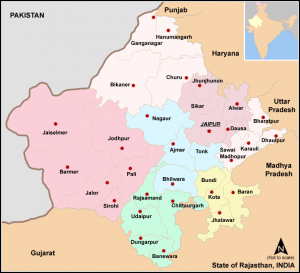Modern history of Rajasthan after Independence
- The former Rajputana encompassed 19 substantial states and 2 chief ships of Kushalgarh, Lava and a British controlled province of Ajmer-Merwara (Merwara-Ajmer).
- The state of Rajastan was a varied accumulation of different political bodies with different systems of administration existing in separate places.
- The current Rajasthani state was formed after a long process of incorporation which began on 17th March 1948 and ended on 1st November 1956.
- Before this integration it was known as Rajputana and after the integration it came to known as Rajasthan. Currently there are 33 districts in the State.
- The name of Rajasthan was probably popularised by Tod and during his lifetime some people believed that he had coined it.
- Although he claimed that it was the classical name for the region, the term seems first to be documented in an inscription dating from 1708 and to have become popular by his time.
Integration of Rajasthan
Seven Stages of formation of Rajasthan (1948-1956)
| S.No. | Name of Group | States | Date of Integration |
| 01. | Matsya Union | Alwar, Bharatpur, Dholpur, Karauli | 17-03-1948 |
| 02. | Rajasthan Union | Banswara, Bundi, Dungerpur, Jhalawar, Kishangarh, Kota, Pratapgarh, Shahpura, Tonk. | 25-03-1948 |
| 03. | United State of Rajasthan | Udaipur also joined with the other Union of Rajasthan. | 18-04-1948 |
| 04. | Greater Rajasthan | Bikaner, Jaipur, Jaisalmer & Jodhpur also joined with the United State of Rajasthan. | 30-03-1949 |
| 05. | United State of Greater Rajasthan | Matsya Union also merged in Greater Rajasthan | 15-05-1949 |
| 06. | United Rajasthan | 18 States of United Rajasthan merged with Princely State Sirohi except Abu and Delwara. | 26-01-1950 |
| 07. | Re-organised Rajasthan | Under the State Re-organisation Act, 1956 the erstwhile part ‘C’ State of Ajmer, Abu Road Taluka, former part of princely State Sirohi which was merged in former Bombay, State and Sunel Tappa region of the former Madhya Bharat merged with Rajasthan and Sironj subdistrict of Jhalawar district was transferred to Madhya Pradesh. | 01-11-1956 |
- It took seven stages to form Rajasthan as defined today. In March 1948 the Matsya Union consisted of Alwar, Bharatpur, Dhaulpur and Karauli was formed.
- Also, in March 1948 Banswara, Bundi, Dungarpur, Jhalawar, Kishangarh, Kota, Pratapgarh, Shahpura and Tonk joined the Indian union and formed a part of Rajasthan.
- In April 1948 Udaipur joined the state and the Maharana of Udaipur was made Rajpramukh. Therefore in 1948 the merger of south and southeastern states was almost complete. Still retaining their independence from India were Jaipur and the desert kingdoms of Bikaner, Jodhpur and Jaisalmer.
- From a security point of view, it was vital to the new Indian Union to ensure that the desert kingdoms were integrated into the new nation.
- The princes finally agreed to sign the Instrument of Accession, and the kingdoms of Bikaner, Jodhpur, Jaisalmer and Jaipur were merged in March 1949.
- This time the Maharaja of Jaipur, Man Singh II was made the Rajpramukh of the state and Jaipur became its capital.
- Later in 1949, the United States of Matsya, comprising the former kingdoms of Bharatpur, Alwar, Karauli and Dholpur, was incorporated into Rajasthan.
- On January 26, 1950, 18 states of united Rajasthan merged with Sirohi to join the state leaving Abu and Dilwara to remain a part of Greater Bombay and now Gujarat.
- In November 1956, under the provisions of the States Re-organisation Act, the erstwhile part ‘C’ state of Ajmer, Abu Road Taluka, former part of Sirohi princely state (which were merged in former Bombay), State and Sunel Tappa region of the former Madhya Bharat merged with Rajasthan and Sirohi sub district of Jhalawar was transferred to Madhya Pradesh.
- Thus giving the existing boundary Rajasthan.
- Today with further reorganisation of the states of Uttar Pradesh, Madhya Pradesh and Bihar.
- Rajasthan has become the largest state of the Indian Republic.
- Gurumukh Nihal Singh was appointed as first governor of Rajasthan. Hiralal Shastri was the first nominated chief minister of the state, taking office on 7 April 1949.
- He was succeeded by two other nominated holders of the office before Tika Ram Paliwal became the first elected chief minister from 3 March 1951.
After State Reorganization
- The princes of the former kingdoms were constitutionally granted handsome remuneration in the form of privy purses and privileges to assist them in the discharge of their financial obligations.
- In 1970, Indira Gandhi, who was then the Prime Minister of India, commenced under-takings to discontinue the privy purses, which were abolished in 1971.
- Many of the former princes still continue to use the title of Maharaja, but the title has little power other than status symbol.
- Many of the Maharajas still hold their palaces and have converted them into profitable hotels, while some have made good in politics.
- The democratically elected Government runs the state with a chief minister as its executive head and the governor as the head of the state.
- Currently, including the new district of Pratapgarh, there are 33 districts, 105 sub-divisions, 37,889 villages, 241 tehsils and 222 towns in Rajasthan.
Political History of Rajasthan
- Politics of Rajasthan is dominated by two parties Bharatiya Janata Party (BJP) and Indian National Congress, now aam aadmi party (AAP) also trying to rope their foot, in Rajasthan.
- The current government in Rajasthan is that of Bharatiya Janata Party. The Chief Minister is Vasundhara Raje.
- Rajasthan’s politics has mainly been dominated by the two state stalwarts, namely, Bhairon Singh Shekhawat and Mohan Lal Sukhadia of the Bharatiya Janata Party and the Indian National Congress respectively.
- Shri Sukhadia ruled Rajasthan for 17 years and died in February 1982 while Late Shri Shekhawat was in the national political horizon. The earlier politics were dominated by the Congress party.
- The main opposition party was the Bharatiya Jansangh, headed by Rajasthan’s most popular leader Bhairon Singh Shekhawat and the Swatantra party headed by former rulers of Rajasthan.
- The Congress rule was untouched till the year 1962. But in 1967, Jansangh headed by Shekhawat and Swatantra party headed by Rajmata Gayatri Devi of Jaipur reached the majority point, but couldn’t form a government.
- In 1972, the Congress won a landslide victory following the victory in the 1971 war. But after the declaration of emergency, Shekhawat became immensely popular, especially after he was forced to be arrested and was sent to Rohtak Jail in Haryana.
- As soon as the emergency was lifted, a joint opposition Janta Party won a thundering landslide victory winning 151 of the 200 seats. Shekhawat became the Chief Minister.
- The government was dismissed by Indira Gandhi in 1980 after she restored power in Delhi.
- In the 1980 elections, the Janta Party split at the centre giving the Congress a victory in Rajasthan.
- Indira Gandhi was assassinated in 1984, and in 1985, a sympathy wave let the Congress sail through in the elections.
- But in 1989, which could be called a Shekhawat wave, the BJP-JD alliance won all 25 Lok Sabha seats and 140 of 200 seats in the assembly. Shekhawat became the Chief Minister for the second term.
- Though Janta Dal took back its support to the Shekhawat government, Shekhawat tore apart the JD and continued to rule as the Chief Minister thus earning the title of master manipulator.
- After the Babri Mosque demolition in Ayodhya, Shekhawat government was suspended by the P.M., Narsimha Rao and President’s rule was enforced in Rajasthan.
- Election took place in 1993 in which his party won even after the breaking of its alliance with the Janta Dal.
- But the then governor Bali Ram Bhagat didn’t allow Shekhawat to form the government, but after immense pressure from Shekhawat, who reached the majority point after supports from independents like Sardar Gurjant Singh, Rani Narendra Kanwar, Sujan Singh Yadav, Rohitashva Kumar Sharma, Kr. Arun Singh, Sundar Lal etc. crossed the majority line of 101 seats in the assembly.
- Shekhawat became the Chief Minister for the third term. This time he ran a successful third term. This was perhaps the diamond phase for Rajasthan as it led to all-round development and Rajasthan also gained identity on the globe as a rapidly developing and beautiful state.Shekhawat introduced Heritage, Desert, Rural, Wildlife tourism to Rajasthan In 1998 elections, the BJP lost heavily due to the onion price rise issue.
- Ashok Gehlot ran a 5 year government. But he lost the Lok Sabha elections in 1999, only 6 months after its victory in the assembly elections.
- Shekhawat became the Vice-President of India in 2002 so he had to leave Rajasthan politics and the BJP. He appointed Vasundhara Raje as his successor.
- She led the BJP in 2003 elections and led it to a victory. She was the Chief Minister of Rajasthan from 2003 – 2008. Narpat Singh Rajvi was the Health Minister, Ghanshyam Tiwari was the Food Minister, and Gulab Chand Kataria was the Home Minister.
- The BJP won the 2004 Lok Sabha elections from here as well.
- But the tables turned in December 2008, when the infighting within the BJP, Raje’s perceived autocratic and despotic rule, and the police excesses in the Gurjar-Meena agitation combined to overcome the incumbent Raje government’s development and growth planks, and the Congress emerged victorious with the support of some independent MLA’s.
- Ashok Gehlot was sworn-in as the new Chief Minister of Rajasthan. In 2013 [Bharatiya Janata Party]] won by very large difference. BJP got 163 seats and Congress got only 21 seats out of 200 seats. Vasundhara Raje became the Chief Minister for second time.
- AAP Rajasthan is expend their wings under the leadership of Sunil Aagiwal who is the convenor of Rajasthan unit. He is a social activist and closly work with Rajiv Diksit, he is come from bhilwara which call textile city of Rajasthan.
- It’s youth wing is lead by Jitendra Puniya who is a dynamic youth leader and always fight for the rights of youth.
- By profesion he is blogger and write blog on various social issues.


